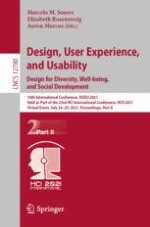2021 | Buch
Design, User Experience, and Usability: Design for Diversity, Well-being, and Social Development
10th International Conference, DUXU 2021, Held as Part of the 23rd HCI International Conference, HCII 2021, Virtual Event, July 24–29, 2021, Proceedings, Part II
herausgegeben von: Marcelo M. Soares, Dr. Elizabeth Rosenzweig, Dr. Aaron Marcus
Verlag: Springer International Publishing
Buchreihe : Lecture Notes in Computer Science
